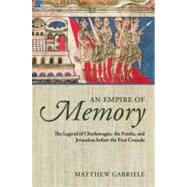
An Empire of Memory The Legend of Charlemagne, the Franks, and Jerusalem before the First Crusade
by Gabriele, MatthewBuy New
Rent Textbook
Rent Digital
Used Textbook
We're Sorry
Sold Out
How Marketplace Works:
- This item is offered by an independent seller and not shipped from our warehouse
- Item details like edition and cover design may differ from our description; see seller's comments before ordering.
- Sellers much confirm and ship within two business days; otherwise, the order will be cancelled and refunded.
- Marketplace purchases cannot be returned to eCampus.com. Contact the seller directly for inquiries; if no response within two days, contact customer service.
- Additional shipping costs apply to Marketplace purchases. Review shipping costs at checkout.
Summary
Paradoxically, Charlemagne became less important to the Charlemagne legend. The legend became a story about the Frankish people, who believed they had held God's favour under Charlemagne and held out hope that they could one day reclaim their special place in sacred history. Indeed, popular versions of the Last Emperor legend, which spoke of a great ruler who would reunite Christendom in preparation for the last battle between good and evil, promised just this to the Franks. Ideas of empire, identity, and Christian religious violence were potent reagents. The mixture of these ideas could remind men of their Frankishness and move them, for example, to take up arms, march to the East, and reclaim their place as defenders of the faith during the First Crusade.
An Empire of Memory uses the legend of Charlemagne, an often-overlooked current in early medieval thought, to look at how the contours of the relationship between East and West moved across centuries, particularly in the period leading up to the First Crusade.
Author Biography
Matthew Gabriele received his Ph.D. in History from the University of California, Berkeley. He has published widely on topics related to Charlemagne, kingship, and religiosity in the eleventh century. He has also co-edited, with Jace Stuckey, an interdisciplinary volume of essays on the medieval legend of Charlemagne entitled The Legend of Charlemagne in the Middle Ages: Power, Faith, and Crusade. His next project investigates how a shift in language signalled a change in how the West understood the relationship between past, present, and future.
Table of Contents
| Acknowledgments | p. viii |
| List of Images | p. x |
| Abbreviations | p. xi |
| Introduction: Looking for Charlemagne | p. 1 |
| The Franks Remember Empire | |
| The Birth of a Frankish Golden Age | p. 13 |
| The Franks after Charlemagne | p. 15 |
| Religious Houses and their Charlemagnes | p. 23 |
| The Expanding Empire | p. 30 |
| The Narratives of Charlemagne's Journey to the East before 1100 | p. 41 |
| A Donation to St. Andrew on Monte Soratte: c.970 | p. 41 |
| The Foundation of Charroux: c.1095 | p. 44 |
| A Capetian Translatio: c. 1080 | p. 51 |
| The Relationship among die Sources | p. 60 |
| Jerusalem | |
| New Jerusalems and Pilgrimage to the East before 1100 | p. 73 |
| Jerusalem and the West before the Eleventh Century | p. 73 |
| Jerusalem and Pilgrimage from the West during the Eleventh Century | p. 79 |
| The Franks Recreate Empire | |
| The Franks' Imagined Empire | p. 97 |
| A Christian Realm | p. 98 |
| The Empire to Come | p. 107 |
| The Franks at the End of History | p. 115 |
| The Franks Return to the Holy Land | p. 129 |
| Frankish Identity in the Eleventh Century | p. 130 |
| Calling the Franks to Holy War: Ideas Become Action | p. 139 |
| Legend for Figure 1.1 | p. 160 |
| Bibliography | p. 164 |
| Index | p. 193 |
| Table of Contents provided by Ingram. All Rights Reserved. |
An electronic version of this book is available through VitalSource.
This book is viewable on PC, Mac, iPhone, iPad, iPod Touch, and most smartphones.
By purchasing, you will be able to view this book online, as well as download it, for the chosen number of days.
Digital License
You are licensing a digital product for a set duration. Durations are set forth in the product description, with "Lifetime" typically meaning five (5) years of online access and permanent download to a supported device. All licenses are non-transferable.
More details can be found here.
A downloadable version of this book is available through the eCampus Reader or compatible Adobe readers.
Applications are available on iOS, Android, PC, Mac, and Windows Mobile platforms.
Please view the compatibility matrix prior to purchase.
